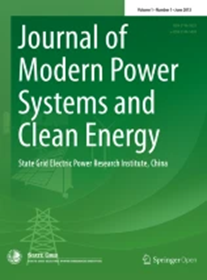考虑攻击资源不确定性的变电站网络攻击防御策略
IF 6.1
1区 工程技术
Q1 ENGINEERING, ELECTRICAL & ELECTRONIC
Journal of Modern Power Systems and Clean Energy
Pub Date : 2025-01-20
DOI:10.35833/MPCE.2024.000375
引用次数: 0
摘要
随着通信和信息技术迅速融入变电站,网络攻击的风险显著增加。攻击者可能渗透到变电站网络,操纵交换机,破坏电力线路,对电力系统造成潜在的严重破坏。为了最大限度地降低这种风险,本文提出了一个三层防御者-攻击者-防御者(DAD)模型,以优化分配有限的防御资源给变电站。为了对现实世界中潜在攻击防御者知识的不确定性进行建模,我们采用了模糊层次分析法结合决策试验和评估实验室(FAHP-DEMATEL)。该方法利用攻击者潜在影响因素的情报数据来考虑攻击资源的不确定性,作为模拟各种攻击场景可能性的评估指标。然后将这些不确定性概率合并到变电站DAD模型中,该模型由三层代理组成:决策者。攻击者和操作者。决策者在攻击前设计了防御策略,而攻击者的目标是识别导致最大负载损失的策略。同时,通过优化潮流调度,使负荷损失最小化。为了求解该模型,将原问题转化为两层子问题和单层主问题,采用列约束生成算法迭代求解。以IEEE RTS-96系统和IEEE 118节点系统为例,验证了该模型的有效性和实用性。对比实验进一步突出了该模型的优越性。本文章由计算机程序翻译,如有差异,请以英文原文为准。
Defense Strategy Against Cyber Attacks on Substations Considering Attack Resource Uncertainty
With the rapid integration of communication and information technology into substations, the risk of cyber attacks has significantly increased. Attackers may infiltrate sub-station networks, manipulate switches, and disrupt power lines, potentially causing severe damage to the power system. To minimize such risks, this paper proposes a three-layer defender-attacker-defender (DAD) model for optimally allocating limited defensive resources to substations. To model the uncertainty surrounding the knowledge of defender of potential attacks in real-world scenarios, we employ a fuzzy analytic hierarchy process combined with the decision-making trial and evaluation laboratory (FAHP-DEMATEL). This method accounts for the attack resource uncertainty by utilizing intelligence data on factors potentially influenced by attackers, which serves as an evaluation metric to simulate the likelihood of various attack scenarios. These uncertainty probabilities are then incorporated into the substation DAD model consisting three layers of agents: the decision-maker., the attacker, and the operator. The decision-maker devises a defense strategy before the attack, while the attacker aims to identify the strategy that causes the maximum load loss. Meanwhile, the operator seeks to minimize the load loss through optimal power flow scheduling. To solve the model, the original problem is transformed into a two-layer subproblem and a single-layer master problem, which are solved iteratively using a column-and-constraint generation algorithm. Case studies conducted on the IEEE RTS-96 system and the IEEE 118-node system demonstrate the effectiveness and practicality of the proposed model. Comparative experiments further highlight the advantages of the proposed model.
求助全文
通过发布文献求助,成功后即可免费获取论文全文。
去求助
来源期刊

Journal of Modern Power Systems and Clean Energy
ENGINEERING, ELECTRICAL & ELECTRONIC-
CiteScore
12.30
自引率
14.30%
发文量
97
审稿时长
13 weeks
期刊介绍:
Journal of Modern Power Systems and Clean Energy (MPCE), commencing from June, 2013, is a newly established, peer-reviewed and quarterly published journal in English. It is the first international power engineering journal originated in mainland China. MPCE publishes original papers, short letters and review articles in the field of modern power systems with focus on smart grid technology and renewable energy integration, etc.
 求助内容:
求助内容: 应助结果提醒方式:
应助结果提醒方式:


